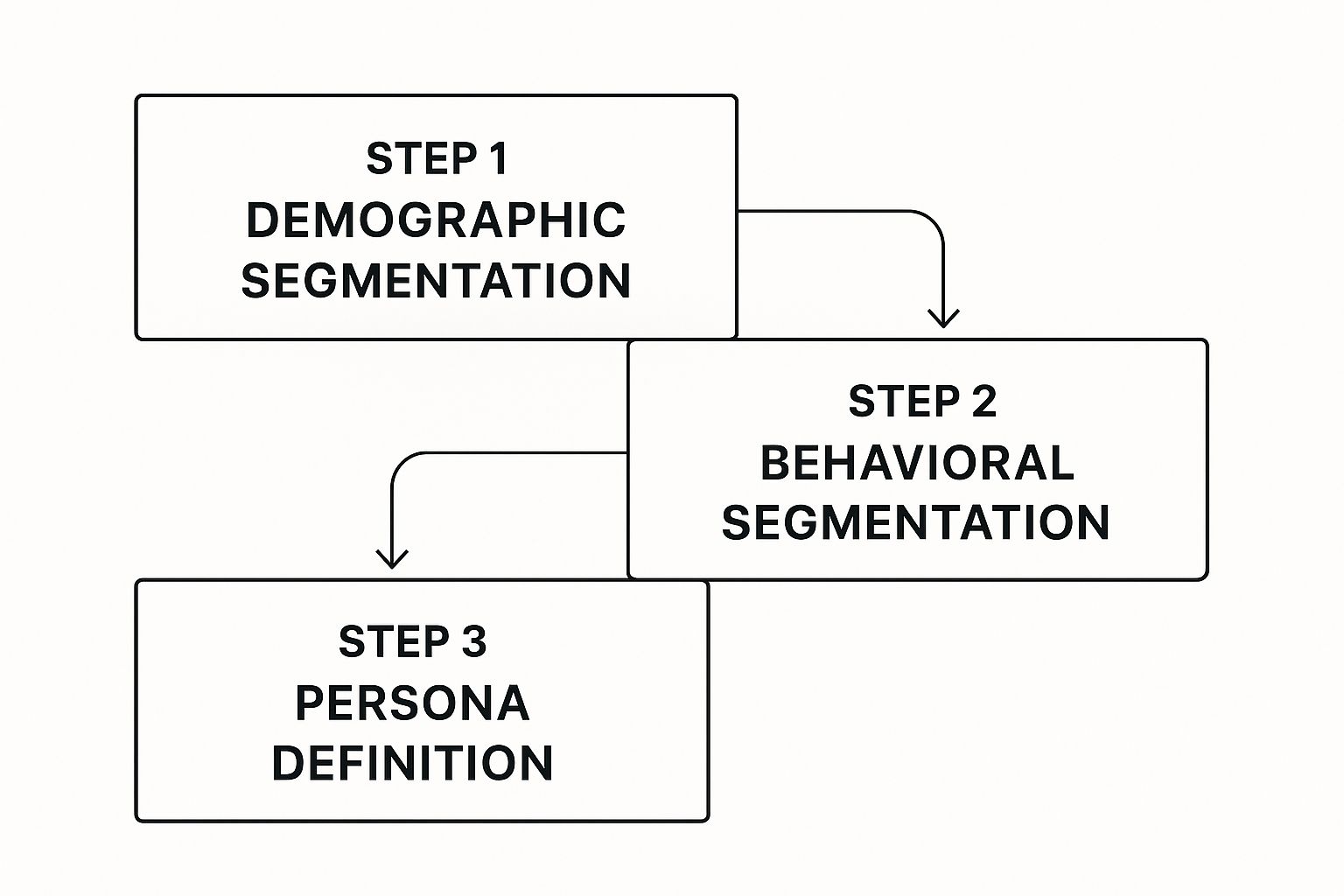Creating buyer personas isn't just a marketing exercise; it's about building a deeply researched profile of your ideal customer. The process involves digging into your audience data, spotting the patterns, and then crafting a detailed character sketch that your entire organization can rally around to make smarter, more customer-focused decisions.
Moving Beyond Guesswork to Real Customer Insights

Let's be honest, those generic customer profiles we’ve all seen? They rarely work. They're often so vague they could describe almost anyone, which means they don't guide your strategy in any meaningful way. This guide is about ditching the fictional characters and, instead, building real, data-backed composites of your best customers.
The goal here is to create a tool that genuinely informs everything from your marketing campaigns to your product roadmap. The most successful SaaS and sales teams I've worked with get this. They know that powerful personas are born from a deep understanding of real people, making them a foundational business asset. It's no surprise that customer-centric companies are a whopping 60% more profitable than those that aren't focused on their customers.
So, What Is a Buyer Persona, Really?
A buyer persona is a semi-fictional, research-based representation of who you want as a customer. Think of it as a detailed character sketch. It goes way beyond basic demographics to include behavior patterns, motivations, and professional goals.
It’s the critical difference between saying, "we target marketing managers," and knowing, "we target Maria, a 34-year-old marketing manager at a mid-sized tech company who is constantly struggling to prove ROI and needs a tool that makes reporting dead simple."
A strong buyer persona brings your target customer to life. It gives you the feeling you’re communicating with a real, tangible person instead of just an abstract set of data points.
Once you know "Maria," that perspective shift is everything. You can tailor your messaging, your content, and even your product features to directly solve her biggest challenges.
Why This Process Matters for Your Business
Investing the time to create accurate buyer personas delivers very real, tangible results. It forces your team to stop making assumptions and start making decisions based on what your customers actually need and want. That alignment is what leads directly to better business outcomes.
Here’s exactly why it’s worth the effort:
- Targeted Marketing That Works: You can create highly relevant content and campaigns that actually resonate with specific audience segments, which naturally drives up engagement.
- Smarter Product Development: Your product team gets a clear guide, helping them prioritize features that solve real problems for your ideal users, not just build what they think is cool.
- Shorter Sales Cycles: When the sales team truly understands a prospect's motivations and pain points, they can tailor their pitch on the fly and close deals faster.
- A United Front: Personas give marketing, sales, product, and support a common language and a shared vision, ensuring everyone is pulling in the same customer-centric direction.
This isn't about abstract theory. The framework in this guide is designed to help you build a practical tool that fuels real, sustainable growth.
Gathering the Raw Materials for Your Personas

Great personas aren't just dreamed up in a boardroom; they're built on a solid foundation of real-world data. Trying to create them based on assumptions is like trying to navigate a new city without a map. You might get somewhere eventually, but the journey will be inefficient and you'll likely end up in the wrong place.
This is where the real work begins. It’s time to put on our detective hats and gather clues from every available source. The goal is to piece together a clear, accurate picture of who our ideal customer truly is.
Blending the "Why" with the "What"
The best approach is to mix two very different, but equally important, types of data. Think of it as pairing what people say with what they actually do.
-
Qualitative Data: This is the story behind the numbers. It’s the rich, narrative insight you get from conversations, interviews, and open-ended survey questions. This is where you uncover motivations, frustrations, and the real "why" behind their actions.
-
Quantitative Data: This is the hard evidence—the "what" and "how many." You'll pull this from your analytics tools, CRM software, and demographic reports. It’s all about spotting patterns and trends at scale.
When you bring these two together, something powerful happens. Your quantitative data might show a high drop-off rate on your pricing page. That's a "what." But a customer interview—your qualitative data—tells you why: they’re confused by the feature tiers. See? One informs the other.
Mine the Gold Hiding in Plain Sight: Your Internal Teams
Before you look anywhere else, look inward. Your sales and customer support teams are on the front lines every single day. They talk directly to prospects and customers, making them an absolute goldmine of qualitative insights.
Book some time with them, but keep it focused. Don't just ask for vague feedback. Get specific.
- "What are the top 3 questions you get on every single demo?"
- "What's the one objection that consistently kills a deal?"
- "Which features make our happiest customers light up?"
- "What's the most common frustration you hear from people submitting support tickets?"
This intel is raw, unfiltered, and incredibly valuable. It’s directly tied to the real-world challenges your audience faces and helps you start speaking their language.
Customer Interviews That Actually Tell You Something
Talking directly to your customers is non-negotiable. Surveys have their place, but nothing beats a one-on-one conversation for uncovering deep insights. The trick is to ask open-ended questions that encourage them to tell a story.
Instead of a leading question like, "Was our onboarding process easy?" try this: "Walk me through your first week using our product. What did that look like for you?" The first gets you a yes or no; the second gets you a story full of details.
The goal of a customer interview isn't to validate your own assumptions. It's to be surprised. The most valuable insights often come from answers you never expected.
Try to interview a mix of your best customers and those who recently churned. Your champions will tell you what you're doing right, while former customers will give you the brutally honest feedback you need to hear about what's going wrong. For more on this, check out our guide on how to identify target customers.
Let the Analytics Tell Their Story
While interviews give you the "why," your analytics platforms deliver the "what." This quantitative data is crucial for validating the stories you've heard and spotting trends you can't see in individual conversations.
Here are a few places to start digging:
-
Google Analytics: Head straight for the Audience and Behavior reports. Where is your traffic coming from? Which pages or blog posts keep them hooked? What paths do they take before they convert—or more importantly, before they leave?
-
CRM Data: Look at the DNA of your most successful deals. What's the average company size? What job titles pop up most often? How long is the typical sales cycle for your best-fit customers?
-
Product Usage Data (for SaaS): This is huge. See how people actually use your product, not just how you think they do. Which features are used constantly? Where do users get stuck? You can often spot clear patterns that separate your power users from those who are about to churn.
By pulling from all these sources, you move beyond guesswork. You're building a persona based on a solid foundation of evidence, ensuring it becomes a reliable tool to guide your entire strategy.
Turning Raw Data Into Meaningful Segments
You've done the hard work. You've got a pile of interview transcripts, survey results, and analytics reports. Now comes the fun part: transforming all that raw information into something you can actually use. This is where you put on your detective hat and start looking for the patterns that will become the bones of your buyer personas.
Forget complex statistical analysis for a moment. Right now, your job is to find the common threads—the shared struggles, goals, and motivations that tie different people together. We're moving beyond simple job titles and company sizes to find groups based on what really drives them.
Here's a look at how you can visualize this process, from initial data grouping to a fully fleshed-out persona.

This gives you a roadmap, showing the logical flow from basic demographics to the deeper behavioral insights that make a persona truly powerful.
Finding Your First Clues in the Data
Your first pass through the data should be a broad scan for recurring themes. This is where a simple spreadsheet becomes your most powerful tool. Start organizing your interview notes and survey responses, just looking for answers that seem to pop up again and again.
Did three different marketing directors mention the same frustration with their current software? Did a dozen survey respondents from the tech industry all list "improving team collaboration" as a primary goal? Those are the threads you need to start pulling.
I find it helpful to create columns for the key attributes you're tracking:
- Job Titles: What specific roles keep appearing?
- Company Size: Are you attracting more startups or established enterprises?
- Primary Goals: What are they trying to accomplish in their day-to-day work?
- Biggest Headaches: What specific obstacles are they constantly running into?
As you fill this out, you'll start to see clusters form organically. You might spot a group of "Project Managers at mid-sized agencies who are struggling to track project profitability." Boom. That's the start of a potential segment.
Going Beyond "Who" to Understand "Why"
Once you have these initial groupings, it's time to dig into the why behind the what. This is where you start blending the rich, qualitative stories from your interviews with the hard, quantitative data from your analytics.
For example, your analytics might show a specific group of users logs in every single morning and immediately runs three specific reports. That's the "what." Your interview notes with people in similar roles might reveal they are under constant pressure from their execs to provide daily performance updates. That's the "why."
By connecting your behavioral data with your interview insights, you build a narrative. This group isn't just a bunch of "active users"; they are "Data-Driven Provers" motivated by a need to justify their team's impact.
This shift from purely anecdotal observations to data-backed profiles is crucial. Modern, effective personas are built on this blend of qualitative and quantitative insight.
Defining Your Core Segments
After sifting through everything, you'll likely have several potential segments. It’s tempting to create a persona for every slight variation you find, but that’s a mistake. It just dilutes your focus. The goal is to lock in on the 3-5 core segments that represent the most significant and valuable portions of your customer base.
Ask yourself two simple questions: Which of these groups represents the most value to our business? And which ones have the most urgent problems that our product is uniquely positioned to solve?
Let's say you're a SaaS company and two clear groups have emerged from your research:
- The "Efficiency Hacker": This person is all about shortcuts, integrations, and advanced features. Their main goal is to automate tasks and claw back time in their day.
- The "Budget Guardian": This person is laser-focused on cost, user adoption rates, and proving ROI. They stick to core features and aren't interested in bells and whistles.
These two groups have completely different needs, motivations, and definitions of success. They absolutely require their own distinct personas. By clearly defining these core groups, you’re laying the foundation to build detailed profiles that will guide everything from product development to your sales outreach. For more inspiration, check out some of the top customer segmentation strategies that leading teams are using.
Turning Raw Data Into a Real Person
This is where the magic happens. All that research, data crunching, and analysis you've done is about to become something real—a living, breathing profile your entire team can actually use. You've identified your key segments; now it's time to give them a face, a name, and a story. We’re officially moving beyond abstract data clusters and creating a humanized profile that feels like a real person who could join your next strategy meeting.

The whole point here is to build a document that tells a story, not just lists facts. This story needs to cover their ambitions, their daily headaches, and the deep-seated motivations that drive their decisions at work. Giving them a name and a stock photo is a start, but the real power comes from weaving a compelling narrative that’s completely grounded in your research.
From Data Points to a Day in the Life
A truly great persona profile goes way beyond a simple list of demographics and job titles. It should paint a crystal-clear picture of what a typical day looks like for this person.
What’s the first thing they do when they sit down at their desk? Which software tabs are permanently open on their browser? What meetings fill them with dread, and which ones actually get them excited?
Answering questions like these helps your team build genuine empathy. For example, knowing your persona is constantly getting roped into last-minute meetings makes it obvious why they'd prefer a quick, scannable blog post over a dense, 30-page whitepaper. This is the kind of context that transforms a persona from a theoretical exercise into a practical, indispensable tool.
The best buyer personas make your team feel like they actually know this person. They stop seeing a "target audience" and start seeing an individual they're trying to help.
To really nail this, you have to bring the customer's voice directly into the profile. One of the most effective ways to do this is by including direct quotes from your interviews. Seriously, a single, powerful quote can capture a major pain point far better than a whole paragraph of your own writing ever could.
Anatomy of a Powerful Persona Profile
It’s crucial to structure your persona document for instant clarity. If it’s a chore to read, your team simply won't use it. Here’s a tried-and-true breakdown of the essential sections to include, making sure your persona is both thorough and easy to scan.
This table lays out the core components of a persona that drives action.
| Section Name | Content to Include | Strategic Purpose |
|---|---|---|
| Background & Demographics | Job title, career path, company size, industry, age, education. | Provides the foundational context you need for smart marketing segmentation. |
| Goals & Motivations | Primary and secondary professional goals. What does success look like in their role? | Helps you align your product’s core value with what they're actually trying to accomplish. |
| Challenges & Pain Points | What obstacles block their progress? What are their biggest daily frustrations? | This is your sweet spot. Your solution should directly solve these specific problems. |
| Watering Holes & Communication | Where do they get their information? Blogs, podcasts, social networks, conferences. | Guides your content and channel strategy. You have to meet them where they already are. |
| Direct Quotes | Verbatim quotes from interviews that perfectly capture their perspective or a key issue. | Adds a dose of reality and makes the persona memorable, credible, and authentic. |
| Common Objections | Why might they say "no" during the sales process? What are their hesitations? | Prepares your sales team to handle pushback and tailor their pitch with confidence. |
Following this structure ensures you’re covering all the bases, from their personal drivers to the practical hurdles your sales team will face.
A Real-World B2B Persona Example
Let's bring this to life. Say your research points to a key segment: marketing managers at mid-sized SaaS companies. After digging through the data, you create "Maria the Marketing Manager."
- Name: Maria Rodriguez
- Role: Marketing Manager at a 150-person B2B SaaS company.
- Background: 34 years old, with a background in content marketing. She’s been in her current role for two years and manages a small team of three.
- Her Day-to-Day: Maria’s calendar is a minefield of campaign check-ins, content reviews, and meetings with sales. She often feels like she spends more time talking about work than actually doing it.
- Primary Goal: To finally prove the ROI of her team's marketing efforts to the C-suite. She's under constant pressure to connect every campaign to pipeline and revenue.
- Biggest Challenge: Her team is juggling five different tools for analytics, social media, and SEO. Just pulling data for a simple report takes hours and is riddled with potential errors.
- Direct Quote: "I feel like I spend the first two days of every month just pulling numbers from different dashboards to build one report. I know the data is there, but I can't get a clear picture of what's actually working without a massive manual effort."
- Watering Holes: Listens to marketing podcasts on her commute, is active in a few private Slack communities for marketers, and follows industry influencers on LinkedIn.
- Common Objections: "We already have a tool that does part of this." "Is this going to be difficult for my team to learn?" "The price seems high for our budget."
This snapshot of Maria immediately creates a shared language across your company. Your marketing team knows exactly what kind of content will stop her mid-scroll (e.g., "How to Build an ROI Report That Wows Your CEO"). Your sales team knows to lead with the platform’s all-in-one reporting. And your product team sees a glaring need for simpler, more customizable dashboards.
This is exactly how a well-crafted persona drives alignment and meaningful action across the entire organization.
Putting Your Personas to Work Across the Company
Building out your buyer personas is a fantastic accomplishment, but it’s really just the halfway point. The most brilliantly researched profiles in the world won't do a bit of good if they’re just sitting in a folder, collecting digital dust. Their true power is only unleashed when they’re woven into the daily habits and strategic thinking of your entire organization.
Think of personas as less of a marketing asset and more of a shared compass. They point everyone—from sales and marketing to product development—toward the same customer-focused goal. When every team is speaking the same language and sees the customer through the same lens, genuine alignment starts to happen on its own.
For Marketing Teams: From Guesswork to Precision
For marketers, a good persona is like a cheat code for creating content that actually hits the mark. Once you have a crystal-clear picture of "Maria the Marketing Manager," your team can finally stop guessing what she cares about and start creating content with real purpose.
You can move beyond vague, generic topics and get right to the heart of her specific problems. Instead of another blog post on "social media tips," you can write a laser-focused article like "How to Build a Social Media ROI Report Your CEO Will Actually Read." See the difference?
Here’s how personas can immediately sharpen your marketing:
- Content That Connects: Map every single piece of content—blogs, webinars, case studies—directly to a persona's known challenges and goals.
- Smarter Channel Strategy: If your persona lives in niche Slack communities and couldn't care less about Facebook, you know exactly where to spend your time and money.
- Hyper-Targeted Ads: Use the demographic and psychographic details from your personas to build incredibly specific ad audiences. This cuts down on wasted spend and drives up conversion rates.
This kind of focused approach is the foundation of effective lead generation. For a deeper dive, check out our guide on how to generate leads for more strategies on turning these insights into real opportunities.
For Sales Teams: Fuel for Smarter Conversations
Your sales team is on the front lines every day. Personas give them the intel they need to have conversations that are meaningful, not just transactional.
When a salesperson knows they're talking to a "Budget Guardian" persona, they can lead the conversation with ROI and total cost of ownership instead of getting bogged down in flashy features that person doesn't care about.
Personas transform a sales pitch from a monologue about your product into a dialogue about the prospect's problems. It’s the difference between selling a product and providing a solution.
They also help your team anticipate objections before they even come up. If you know "Maria" is probably worried about a difficult implementation, your rep can proactively talk about how simple your onboarding process is. That simple shift builds trust and paves a much smoother path to closing the deal.
For Product Development: A Guide for What to Build Next
One of the toughest jobs for a product team is deciding what to build next. Personas provide the framework to make those decisions based on what real customers actually need, not just on what sounds like a cool idea internally.
When a new feature request comes in, the team can ask a simple but powerful question: "Which of our personas does this serve, and how critical is it to solving their main problem?" This keeps the team from chasing niche features for a handful of outlier customers, letting them focus on core improvements that benefit your ideal users.
For example, if your "Efficiency Hacker" persona is getting frustrated by a clunky workflow, prioritizing an integration that saves them 30 minutes a day becomes a no-brainer. Personas give your product team the empathy to build a tool that people don't just use, but one they actually love.
Don't just take our word for it—the data backs this up. Research shows that while 44% of marketers have used buyer personas, the highest-performing companies have mapped over 90% of their customer database by persona. This kind of segmentation gets results; companies that refresh their personas within six months are over 60% more likely to blow past their lead and revenue goals. You can discover more insights about these persona statistics and see the impact for yourself.
A Few Common Questions About Buyer Personas
As you start building out your buyer personas, a few questions always seem to pop up. Let's clear the air on some of the most common ones so you can sidestep the usual hurdles and create personas that actually work for your team.
How Many Buyer Personas Do We Really Need?
It’s tempting to create a persona for every little customer variation you can think of, but that’s a quick way to overcomplicate things. You'll end up with a strategy that's too scattered to be effective.
The real sweet spot for most businesses is somewhere between 3 to 5 core personas. These should be your most important, valuable, and distinct customer groups. If you're just getting started, don't overwhelm yourself. Just focus on your single most important persona—the one that brings in the most revenue or represents the biggest growth opportunity.
My rule of thumb? If two of your potential personas have almost the same goals, motivations, and problems, just merge them. The whole point is to bring clarity to your strategy, not to map out every single person who might buy from you.
How Often Should We Update These Things?
Your buyer personas aren't a "set it and forget it" project. Think of them as living documents that need to evolve along with your business and your market. What your customers care about today might be completely different a year from now.
I recommend a formal review at least once a year. But you should also be ready to jump in and make changes whenever something big happens, like:
- A major product update: New features might bring in a totally different kind of user.
- A big market shift: A new competitor or a change in the economy can completely alter your customers' priorities.
- Your own data is telling you something new: If you start seeing new behaviors or challenges pop up in your analytics or sales calls, it’s time for a refresh.
What Are the Biggest Mistakes People Make?
Knowing what not to do is just as important as knowing what to do. The absolute biggest mistake I see is when teams create personas based on assumptions and internal brainstorming sessions instead of talking to actual customers. This just leads to fictional characters that will point your entire strategy in the wrong direction.
Another classic error is getting bogged down in useless details. It might be fun to know your persona’s favorite TV show, but if it has zero impact on how they buy your software, it's just noise. Stick to what matters for their purchasing decisions.
And finally, the most frustrating mistake of all is creating incredibly insightful, data-driven personas and then letting them collect digital dust in a shared drive. If they aren't being used in marketing meetings, sales training, and product development, they’re worthless.
Should We Bother With a "Negative" Buyer Persona?
Yes, you absolutely should. A "negative" or "exclusionary" persona—a profile of the customer you don't want—is one of the smartest strategic tools you can create.
This is the person who:
- Costs way too much to acquire for what they're worth.
- Always churns because your product was never the right fit.
- Drains your support team’s time and resources.
- Is just a student or tire-kicker looking for free stuff.
By clearly defining who you aren’t selling to, you empower your team to qualify leads better, stop wasting marketing dollars, and pour all their energy into attracting the right customers—the ones who will stick around and succeed.
Ready to find the right decision-makers for your newly defined personas? The Nordic Lead Database gives you access to the most extensive database of companies and key contacts in the Nordic region, helping your sales and SaaS teams connect with your ideal customers. Find your next lead today.
